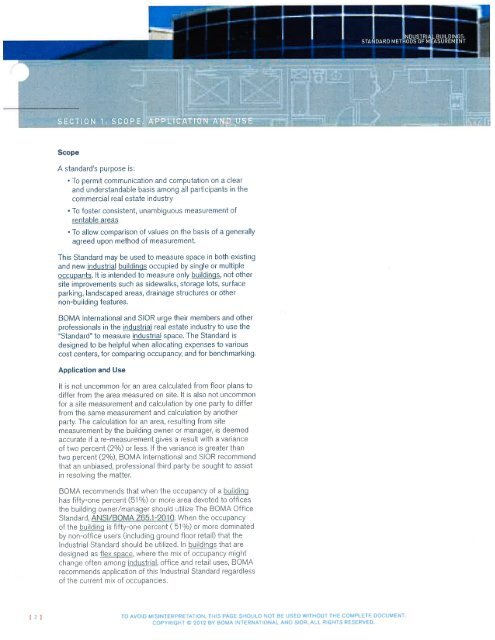BOMA
BOMA_Industrial_Buildings_Standard_Methods_of_Measurements_2016
BOMA_Industrial_Buildings_Standard_Methods_of_Measurements_2016
You also want an ePaper? Increase the reach of your titles
YUMPU automatically turns print PDFs into web optimized ePapers that Google loves.
Scope<br />
A standard's purpose is:<br />
. To permit communication and computation on a clear<br />
and understandable basis among all participants in the<br />
commercial real estate industry<br />
. To foster consistent, unambiguous measurement of<br />
rentable areas<br />
. To allow comparison of values on the basis of a generally<br />
agreed upon method of measurement,<br />
This Standard may be used to measure space in both existlng<br />
and new industrial buildings occupíed by single or multiple<br />
occupants. lt is intended to measure only buildings, not other<br />
site improvements such as sidewalks, storage lots, surface<br />
parking, landscaped areas, drainage structures or other<br />
non-building features.<br />
<strong>BOMA</strong> lnternational and SIOR urge their members and other<br />
professionals in the industrial real estate industry to use the<br />
"Standard" to measure industrial space. The Standard is<br />
designed io be helpful when allocating expenses to various<br />
cost centers, for comparing occupancy, and for benchmarking.<br />
Application and Use<br />
It is not uncommon {or an area calculated from floor plans to<br />
differ from the area measured on site. lt is also not uncommon<br />
for a site measurement and calculation by one party to differ<br />
from the same measurement and calculation by another<br />
party. The calculation for an area, resulting from site<br />
measurement by the building owner or manager, is deemed<br />
accurate if a re-measurement gives a result with a variance<br />
of two percenl (20/o) or less. lf the variance is greater than<br />
two percent (20lo), <strong>BOMA</strong> lnternational and SIOR recommend<br />
that an unbiased, professional third party be sought to assist<br />
in resolving the matter.<br />
<strong>BOMA</strong> recommends that when the occupancy of a building<br />
has fifty-one percent (51 0/o) or more area devoted io offices<br />
the building owner/manager should utilize The <strong>BOMA</strong> Office<br />
Siandard, ANSI/<strong>BOMA</strong> 265.1-2010. When the occupancy<br />
of the building is fifty-one percent ( 510/o) or more dominated<br />
by non-office users (including ground floor retail) that the<br />
lndustrial Standard should be utilized. ln buildings that are<br />
designed as flex space, where the mix of occupancy might<br />
change often among industrial, office and retail uses, <strong>BOMA</strong><br />
recommends application of ihis lndustrial Standard regardless<br />
of the current mix of occupancies.<br />
t,21 TO AVOID MISINTERPRETATION, THIS PAGE SHOULD NOT BE USED WITHOUT THE COMPLETE DOCUIVENT<br />
COPYRIGHT O 20I2 BY BO[/A INTERNATIONAL AND SIOR, ALL RIGHTS RESERVED.


